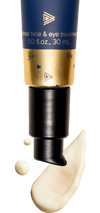The skincare world is never short of the newest, glitziest active ingredient vying for your attention. But while trendy ingredients can come and go, retinol and glycolic acid are two workhorse active ingredients that consistently top the chart. Both of these come with a rich history of clinical data on treating uneven pigmentation, fine lines and wrinkles. However, given that these are both heavy hitting actives that come with a risk for skin irritation, you might be wondering: can you actually use glycolic acid with retinol in the same skincare routine? Spoiler alert! You absolutely can with some know-how. So in this blog, we’ll dive into the difference between the two ingredients, what are the risks associated with having both in your routine, and how to effectively incorporate both into your routine
Glycolic Acid vs. Retinol 101
When we talk about actives layering strategy, it is helpful to understand just how they work on skin
- Glycolic Acid is an alpha hydroxy acid (AHA) and acts as a chemical exfoliant. It works by weakening the protein bonds that bind old, dead cells together. This is a simple, yet crucial step in maintaining skin health. Excessive build up of old dead cells is the root cause of a slew of skin issues like dullness, texture change, and dryness. You can learn more about AHAs in our deep dive blog post here.
- Retinol is a retinoid with a long history of use. It works on skin by converting into retinoic acid and stimulate skin’s retinoid receptor. Through this pathway, skin cell proliferation gets a big boost. New juicy cells = smoother, brighter, plumpier skin!
As you can see, the two work on skin in very different ways. When you have both in your routine, you can reap the benefits of both ingredients. But! It’s not as simple as just slapping both on your face and wait for results.
How to (Successfully!) Incorporate both Glycolic Acid and Retinol in Your Skincare Routine
If you’re ready to to incorporate both glycolic acid and retinol in your routine, here are some key strategies to keep in mind to keep irritation at bay:
- Start slow: if you’re pretty new to skin actives, start with just retinol. Acclimate to retinol first by using it every other night for 2 to 4 weeks before ramping up retinol to nightly use. Once your skin has adjusted to retinol, you can incorporate glycolic acid. Consider starting with an exfoliating toner with glycolic acid. If skin is well-adjusted, and you’d like to take efficacy up a notch, consider a home peel to use once a week.
- Think lower concentrations: you don’t always have to reach for that 1% high dose retinol for it to work. Especially if you’re trying to incorporate glycolic acid in your routine as well. Consider sticking to a 0.3% to 0.5% retinol for the long term if you’re having a hard time with retinol side effects.
- Alternating days: another way to incorporate both is to simply use them on alternating days of your routine. We personally love using retinol nightly and skipping a night for a high level glycolic acid home peel night!
- Include Soothers: soothing ingredients like centella, allantoin, or bisabolol can help ease skin into using these power actives. A soothing, hydrating serum is your best friend here!
- Don’t forget that moisturizer & SPF! Nothing is worse than frying your brand new cells in the sun. Love thy barrier by using a nourishing moisturizer and daily SPF.
- Listen to your skin: everyone’s skin is different especially in the actives tolerance department! When using these two actives (together or separately), you might experience some irritation. While mild signs of irritation are normal (think light redness, mild discomfort, initial peeling), it shouldn’t feel like your skin is expelling demons. Dial back frequency if needed!
Takeaways
Glycolic acid and retinol are two fantastic, proven active ingredients that can bring about skin benefits in very different ways. They can work together in the same routine for better all around results. But! The two are both prone to causing irritation. Proceed with caution and listen to your skin every step along the way. It may take some time and some experimenting, but by going low and slow, you can successfully incorporate both in your routine. We promise you it’ll be worth the effort in the end!








